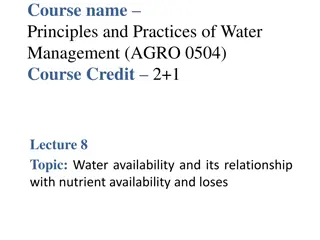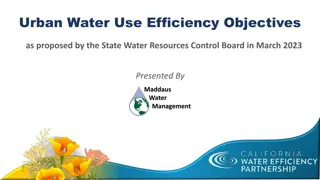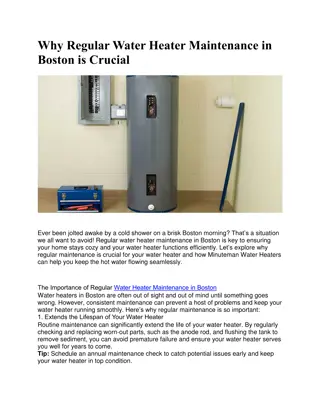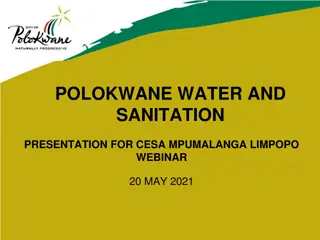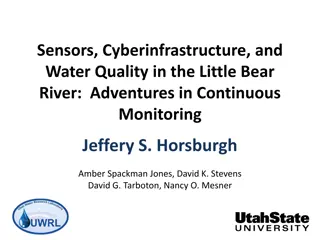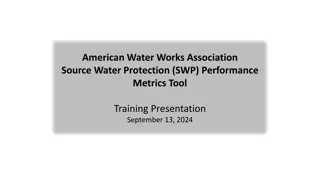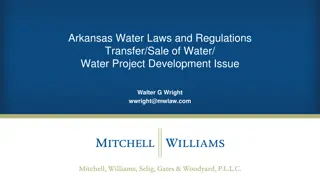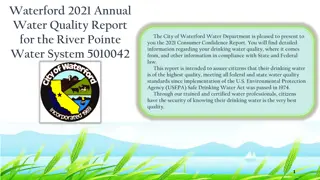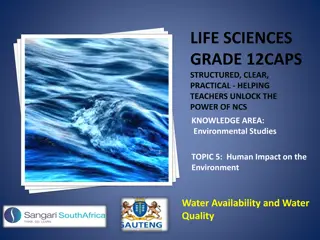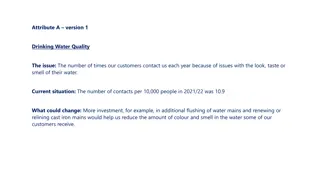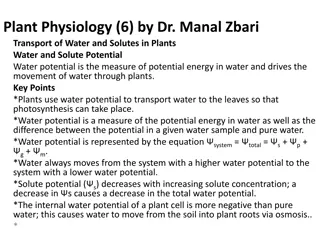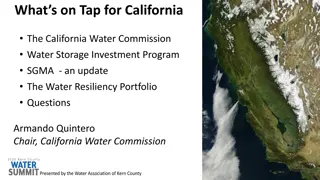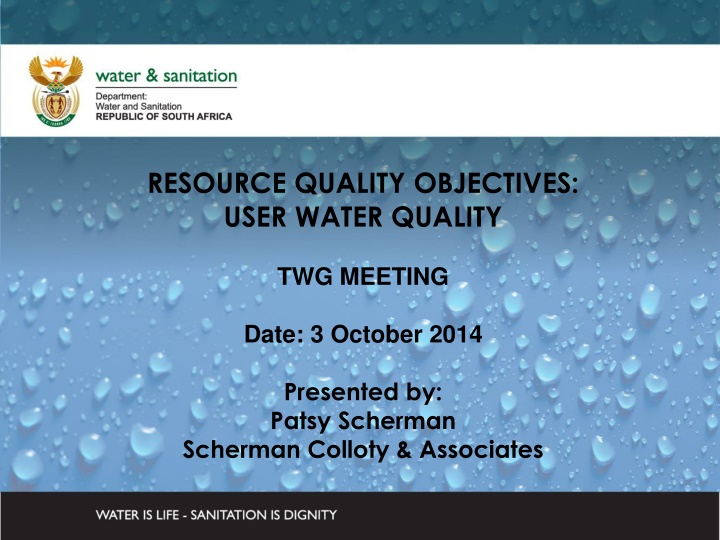
Steps Towards Water Quality Objectives for Users
This presentation discusses the integrated steps involved in determining resource quality objectives related to water quality for users, both ecological and non-ecological. It covers processes such as identifying priority resource units, evaluating scenarios, determining driving variables, and setting water quality requirements based on user needs. The focus is on ensuring water quality for various user specifications like irrigation, domestic use, recreation, and industrial purposes.
Download Presentation

Please find below an Image/Link to download the presentation.
The content on the website is provided AS IS for your information and personal use only. It may not be sold, licensed, or shared on other websites without obtaining consent from the author. If you encounter any issues during the download, it is possible that the publisher has removed the file from their server.
You are allowed to download the files provided on this website for personal or commercial use, subject to the condition that they are used lawfully. All files are the property of their respective owners.
The content on the website is provided AS IS for your information and personal use only. It may not be sold, licensed, or shared on other websites without obtaining consent from the author.
E N D
Presentation Transcript
RESOURCE QUALITY OBJECTIVES: USER WATER QUALITY DWA CORPORATE IDENTITY Presented by: Johan Maree Deputy Director: Media Production TWG MEETING 12 December 2012 Date: 3 October 2014 Presented by: Patsy Scherman Scherman Colloty & Associates
NWRCS INTEGRATED STEPS 1: Delineate units of analysis and describe the status quo 2: Initiation of stakeholder process and catchment visioning 3: Quantify EWRs and changes in Ecosystem Services 4: Identification and evaluation of scenarios within IWRM 5: Draft Management Classes 6: Resource Quality Objectives (EcoSpecs & water quality (user)) 7: Gazette class configuration WHERE DO RQOs (FITNESS FOR USE) FIT IN?
USER (NON-ECOLOGICAL) WATER QUALITY STEPS The determination of RQOs and evaluation of scenarios for this component are inter-linked between Step 1, 4, 5 and 6. The sequence of actions are described below: Identify priority RUs and water quality hotspots Identify driving variables Determine consequences on driving variables Identify range of scenarios (Step 4) Rank scenarios Scenario, MC and catchment configuration selected (Step 5) Determine Userspecs as part of RQOs for selected MC
STEPS 4 and 6: WATER QUALITY Water quality = two broad components Ecological, i.e. as part of the EWR or Reserve process. Output = EcoSpecs. Non-ecological, i.e. UserSpecs (excl. aquatic ecosystems). UserSpecs and consequences of scenarios (Step 4) Wq included as a service identified in ECOSYSTEM SERVICES Wq included indirectly in the ECONOMICS in terms of water treatment costs USER WQ: Evaluate Impact of scenarios on users by (1) identifying primary user, (2) identifying driving wq variables + (3) use of model (quantitative) or alternative qualitative approach
STEP 6: RQOs WATER QUALITY For RQOs focus is on the following for Userspecs, i.e. uses such as irrigation + stock-watering, domestic, recreation, industrial: Collect background information Identify priority resource units (as part of the Task 1 hotspot process) Identify users + their locations within those RUs Identify driving users ito water quality Identify wq requirements of user groups Identify wq variables that drive wq state or requirements
STEP 6: RQOs WATER QUALITY Background information to inform the process: Land use + water quality status quo (a study deliverable) Identification of user groups in the catchments Output from Classification, i.e. catchment configurations and Management Classes Data gathering, e.g. water quality objectives drafted by DWA: Water Quality Planning (see example below) EcoSpecs from the EWR / Reserve study Integration of outputs, i.e. EcoSpecs (as A-F categories) and UserSpecs (as Ideal Unacceptable) Categories A and A/B = Ideal, B, B/C and C = Acceptable, C/D and D = Tolerable
STEP 6: RQOs WATER QUALITY: U4 Water quality objectives Average *1.5 WQ objective Variable Units Bound Average_value Percentile Ideal Acceptable Tolerable User Alkalinity (CaCO3) mg/l Upper 58.7 88.09 95 99 300 450 600 In3 Ammonia (NH3-N) mg/l Upper 0.01 0.015 95 0.015 0.015 0.058 0.1 EWQG Calcium (Ca) mg/l Upper 9.4 14.07 95 14.1 10 80 80 Dom Dom AIr In3 Chloride (Cl) mg/l Upper 12.7 19.08 95 19.1 100 137.5 175 EC mS/m Upper 16.5 24.75 95 25 30 70 85 Dom Fluoride (F) mg/l Upper 0.1 0.22 95 0.2 0.7 1 1.5 Dom Magnesium (Mg) mg/l Upper 6.5 9.8 95 10.0 70 100 100 Dom NO2 and NO3 mg/l Upper 0.8 1.18 95 1.2 6 10 20 Dom pH units Upper n/a 8.4 95 8.4 8 8.4 8.4 BHN In3 BHN AIr In3 Lower n/a 6.5 5 6.5 6.5 6.5 6.5 Potassium (K) mg/l Upper 2.3 3.41 95 3.4 25 50 100 Dom PO4-P mg/l Upper 0.006 0.009 50 0.009 0.005 0.02 0.125 EWQG SAR mmol/l Upper 0.7 1.06 95 1.1 2 8 15 AIr Sodium (Na) mg/l Upper 9.0 13.44 95 14.0 70 92.5 115 AIr SO4. mg/l Upper 7.6 11.36 95 11.4 200 250 300 Dom In3 Si mg/l Upper 7 10.5 95 11 20 85 150 In3 Hardness (CaCO3) mg/l Upper 47.8 71.7 95 72 200 300 500 Dom
STEP 6: RQOs WATER QUALITY Outputs Water quality portion of the RQOs (aka Resource Water Quality Objectives) as the most stringent objectives considering all users (i.e. EcoSpecs and UserSpecs) Narrative and qualitative statements will be used to describe water quality objectives Numerical limits provide a quantitative measure to be used for monitoring purposes and auditing compliance Main focus: An assessment of whether current levels of protection are adequate for the system All RQOs are linked to the catchment configurations that make up the Management Class of IUAs
OBJECTIVES OF THIS MEETING ITO USER WATER QUALITY Aims of TWG meeting water quality user session: Confirm priority resource units (larger group) Identify users + their locations within those RUs Identify driving users ito water quality Identify wq variables that drive wq state or requirements Priority WQ hotspots Primary PES Driver WQ hotspot comment WQ users WQ variables SQ SQ_NAME RU IUA Biota and habitat component indicators IUA U4-1 & U4-2 U40B-03770 Mv_I_EWR1 Heinespruit MRU Heyns A U4-1 Agriculture, urban (WWTW) Nutrients, salts, toxics, E. coli Non-flow: Forestry, Agriculture (veg removal) Barrier Pesticides + nutrients; WWTW 3 4 U40A-03869 Mvoti MRU Mvoti A U4-1 Nutrients, salts, toxics? Non-flow: Forestry, Agriculture (veg removal) Flow: Centre pivot, dams in tribs 3 Agriculture U40B-03708 Intinda Non-flow: Forestry, Agriculture (veg removal) Barriers 1. Riparian vegetaion 2. Instream biota 3. Water quality U40B-03740 Mvozana Non-flow: Forestry, Agriculture (veg removal) Barrier. Inundation. 2, 3WQ Agriculture Nutrients, salts RU Mv 1 U4-1 Non flow: Agriculture (veg removal). Barriers, Veg removal, water quality Flow: Abstraction for irrigation. U40B-03832 Mvozana 3



